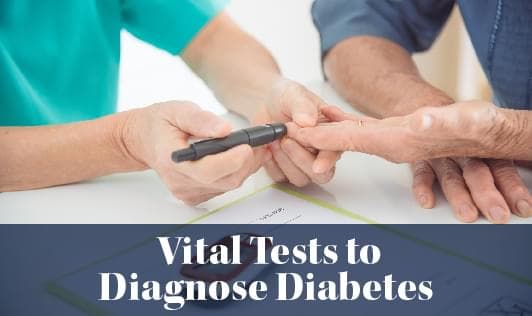Vital Tests to Diagnose Diabetes
51 months ago
4 minute read.

Diabetes often remains undiagnosed until symptoms become severe. If left untreated, diabetes can cause numerous health complications. That’s why it’s crucial to know the warning signs.
Symptoms of Type 1 diabetes often appear suddenly and are often the reason for checking blood sugar levels. Because symptoms of other types of diabetes and prediabetes come on more gradually or may not be evident.
Anyone who has symptoms of diabetes should be tested for the disease. Some people will not have any symptoms but may have risk factors for diabetes and need to be tested. Testing allows health care professionals to find diabetes sooner and work with their patients to manage diabetes and prevent complications. Testing also allows health care professionals to find prediabetes.
Symptoms for Diabetes that People May Experience
If you have any of these symptoms, see your health care provider right away. Diabetes can only be diagnosed by your healthcare provider.
- Increased or extreme thirst
- Increased appetite
- Increased fatigue
- Frequent urination, especially at night
- Unusual weight loss
- Blurred vision
- Fruity odor or breath Sores that do not heal
Also note: In some cases, there might be no symptoms
Who should be tested for prediabetes and diabetes?
It is recommended that you should be tested if you are:
- Overweight and older than 45 years
- Overweight, younger than 45 and have one or more additional risk factors, such as: High blood pressure, High cholesterol, A family history of diabetes
- A history of gestational diabetes (diabetes during pregnancy) or delivering a baby more than 9 pounds
If your blood glucose levels are normal, you should be tested every three years. If you have prediabetes, you should be checked for diabetes every one to two years after that diagnosis.
Tests for Diagnosing Prediabetes and Diabetes
Three types of tests can help healthcare providers make a diagnosis of prediabetes and diabetes:
1.HbA1C (A1C or Glycosylated Hemoglobin Test)
2.Fasting Plasma Glucose Test (FPG)
3.Oral Glucose Tolerance Test (OGTT)
1. HbA1C (A1C or Glycosylated Hemoglobin Test)
The A1C test can diagnose prediabetes and diabetes. It measures your average blood glucose control for the past two to three months. This test is more convenient because no fasting is required. An A1C of 5.7 percent to 6.4 percent means that you have prediabetes, and you’re at high risk for the development of diabetes. Diabetes is diagnosed when the A1C is 6.5 percent or higher.
2. Fasting Plasma Glucose Test (FPG)
A fasting plasma glucose test requires fasting (nothing to eat or drink except water) for eight hours before the test.
The table below contains the FPG test’s blood glucose ranges for prediabetes and diabetes, and describes what each diagnosis means:
|
Blood Glucose Range
|
Diagnosis
|
What it means
|
|
100 to 125 mg/dL
|
Prediabetes (also called Impaired Fasting Glucose)
|
Blood glucose levels are higher than normal, but not high enough to be diagnosed as diabetes. This condition increases the risk of developing Type 2 diabetes, heart disease, and stroke.
|
|
126 mg/ dL or more
|
Diabetes mellitus (type 2 diabetes)
|
Type 2 diabetes develops when your body doesn’t make enough insulin or develops “insulin resistance” and can't efficiently use the insulin it makes. It greatly increases your risk of heart disease and stroke.
|
3. Oral Glucose Tolerance Test (OGTT)
This test measures how well the body handles a standard amount of glucose.
To conduct this test, your healthcare provider will draw blood before and two hours after you drink a large, premeasured beverage containing glucose. Then, your doctor can compare the before-and-after glucose levels contained in your plasma to see how well your body processed the sugar.
The table below contains the oral glucose tolerance test (OGTT) ranges for prediabetes and diabetes, as well as what each diagnosis means:
|
Blood Glucose Range
|
Diagnosis
|
What it means
|
|
140 to 199 mg/dL
|
Prediabetes (also called Impaired Fasting Glucose)
|
Blood glucose levels are higher than normal, but not high enough to be diagnosed as diabetes. This condition increases the risk of developing Type 2 diabetes, heart disease, and stroke.
|
|
200 mg/dL or higher
|
Diabetes mellitus (type 2 diabetes)
|
Type 2 diabetes develops when your body doesn’t make enough insulin or develops “insulin resistance” and can’t efficiently use the insulin it makes. It greatly increases your risk of heart disease and stroke.
|
Test for Monitoring Type 2 Diabetes
If you’re diagnosed with Type 2 diabetes, you can monitor your blood sugar level several ways to evaluate how well your treatment plan is working:
HbA1C (A1C or Glycosylated Hemoglobin Test)
Your healthcare provider may regularly perform a test called HbA1c (A1C, or Glycosylated Hemoglobin Test).
An A1C test provides a picture of your average blood sugar control for the past two to three months. Blood sugar is measured by the amount of glycosylated hemoglobin (A1C) in your blood.
Do you want to keep your blood sugar levels under the track or your doctor has recommended to get diabetes tests done?. Find out the list of diabetes checkup packages with complete pricing.

Leave a Comment
Related Articles
Health Checks @ Home
Service
Explore
© 2025 Truworth Health Technologies Pvt. Ltd.




